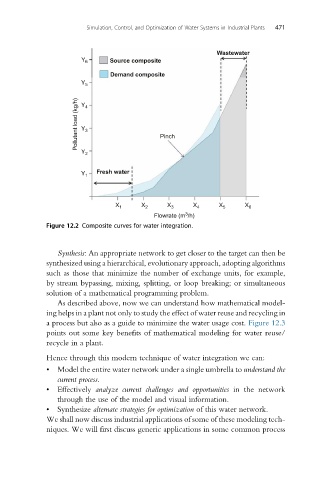Page 501 - Industrial Wastewater Treatment, Recycling and Reuse
P. 501
Simulation, Control, and Optimization of Water Systems in Industrial Plants 471
Wastewater
Y 6 Source composite
Demand composite
Y 5
Pollutant load (kg/h) Y 4 3 Pinch
Y
Y 2
Y 1 Fresh water
X 1 X 2 X 3 X 4 X 5 X 6
3
Flowrate (m /h)
Figure 12.2 Composite curves for water integration.
Synthesis: An appropriate network to get closer to the target can then be
synthesized using a hierarchical, evolutionary approach, adopting algorithms
such as those that minimize the number of exchange units, for example,
by stream bypassing, mixing, splitting, or loop breaking; or simultaneous
solution of a mathematical programming problem.
As described above, now we can understand how mathematical model-
ing helps in a plant not only to study the effect of water reuse and recycling in
a process but also as a guide to minimize the water usage cost. Figure 12.3
points out some key benefits of mathematical modeling for water reuse/
recycle in a plant.
Hence through this modern technique of water integration we can:
• Model the entire water network under a single umbrella to understand the
current process.
• Effectively analyze current challenges and opportunities in the network
through the use of the model and visual information.
• Synthesize alternate strategies for optimization of this water network.
We shall now discuss industrial applications of some of these modeling tech-
niques. We will first discuss generic applications in some common process

